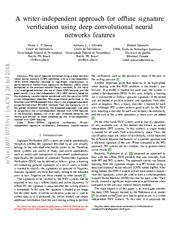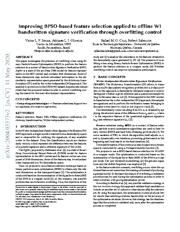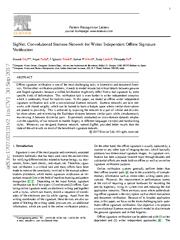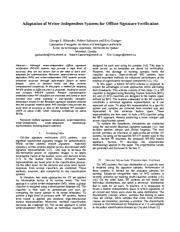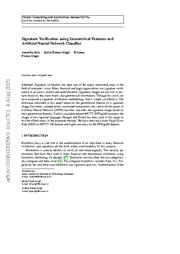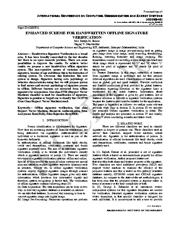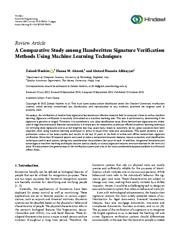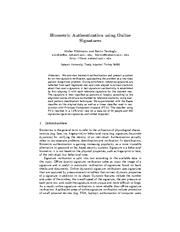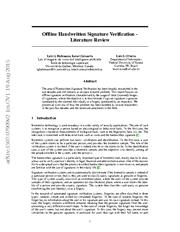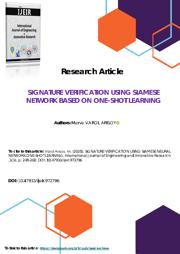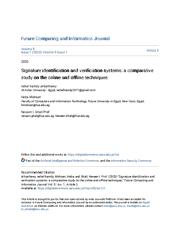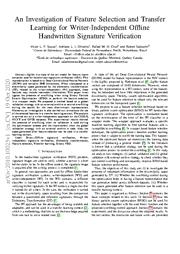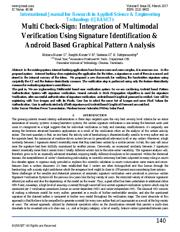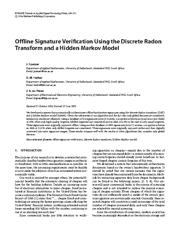A copy of this work was available on the public web and has been preserved in the Wayback Machine. The capture dates from 2020; you can also visit the original URL.
The file type is application/pdf.
Filters
A writer-independent approach for offline signature verification using deep convolutional neural networks features
[article]
2018
arXiv
pre-print
In this work it is investigated whether the use of these CNN features provide good results in a writer-independent (WI) HSV context, based on the dichotomy transformation combined with the use of an SVM ...
The use of features extracted using a deep convolutional neural network (CNN) combined with a writer-dependent (WD) SVM classifier resulted in significant improvement in performance of handwritten signature ...
CONCLUSION This paper has introduced an approach for writer-independent offline signature verification that uses the dissimilarity representation of the deep CNN features from [3] and a single SVM as ...
arXiv:1807.10755v1
fatcat:2yatslgkare6pihftpuvpesqve
Improving BPSO-based feature selection applied to offline WI handwritten signature verification through overfitting control
[article]
2020
arXiv
pre-print
Some of these dimensions may include redundant information in the dissimilarity representation space generated by the dichotomy transformation (DT) used by the writer-independent (WI) approach. ...
This paper investigates the presence of overfitting when using Binary Particle Swarm Optimization (BPSO) to perform the feature selection in a context of Handwritten Signature Verification (HSV). ...
CONCLUSIONS In this work, we evaluated the use of BPSO-based feature selection for offline writer-independent handwritten signature verification. ...
arXiv:2004.03373v2
fatcat:kjj37wsunfgejcvw6t3fkgl7ze
SigNet: Convolutional Siamese Network for Writer Independent Offline Signature Verification
[article]
2017
arXiv
pre-print
In this paper, we model an offline writer independent signature verification task with a convolutional Siamese network. ...
Offline signature verification is one of the most challenging tasks in biometrics and document forensics. ...
The TITAN X Pascal GPU used for this research was donated by the NVIDIA Corporation. ...
arXiv:1707.02131v2
fatcat:hrkneauasjfxzepl3tuomduakq
Adaptation of Writer-Independent Systems for Offline Signature Verification
2012
2012 International Conference on Frontiers in Handwriting Recognition
Although writer-independent offline signature verification (WI-SV) systems may provide a high level of accuracy, they are not secure due to the need to store user templates for authentication. ...
Moreover, state-of-the-art writerdependent (WD) and writer-independent (WI) systems provide enhanced accuracy through information fusion at either feature, score or decision levels, but they increase computational ...
OFFLINE SIGNATURE VERIFICATION SYSTEMS For WD systems, the class distribution of a specific user is modeled using his signature samples. ...
doi:10.1109/icfhr.2012.175
dblp:conf/icfhr/EskanderSG12
fatcat:kknr3r3mujedligmj5dda2zk44
Signature verification using geometrical features and artificial neural network classifier
2020
Neural computing & applications (Print)
ANN) classifier, classifies the signature image based on their geometrical features. ...
Many financial and legal organizations use signature verification as access control and authentication. ...
Code availability Once the manuscript is accepted, we will release the code used in the manuscript. ...
doi:10.1007/s00521-020-05473-7
fatcat:45joea3mfffdjkismlbevi3ms4
Enhanced Scheme For Handwritten Offline Signature Verification
2016
Zenodo
Different features are extracted from offline signature for comparison. One-class SVM (Support Vector Machine) classifier is used for classification of signature. ...
Signature is genuine or forged one to classify that OCSVM (One-Class Support Vector Machine) used. https://www.ijiert.org/paper-details?paper_id=140601 ...
Author proposed a framework which utilize algorithm are a Discrete Radon transform and a dynamic time warping in dissimilarity space for the representation of writer-independent signature, and a writer-specific ...
doi:10.5281/zenodo.1468799
fatcat:m4ygmb4zpjf2zcbmde43iutgxe
A Comparative Study among Handwritten Signature Verification Methods Using Machine Learning Techniques
2022
Scientific Programming
This paper presents a comprehensive review of the latest studies and results in the last 10 years in the field of online and offline handwritten signature verification. ...
In addition, the general limitations and advantages of machine-learning techniques that are used to classify or extract signature features were summarized in the form of a table. ...
Writer-independent decision thresholding e verification step is performed using only the feature dissimilarity measure (1) AER for CEDAR is 2.10 (2) AER for GPDS is 18.42
Table 3 : 3 Continued. ...
doi:10.1155/2022/8170424
fatcat:7jgjvrggqnf2dlokh7uiac7xnm
Biometric Authentication Using Online Signatures
[chapter]
2004
Lecture Notes in Computer Science
We overview biometric authentication and present a system for on-line signature verification, approaching the problem as a two-class pattern recognition problem. ...
We experimented with the Bayes classifier on the original data, as well as a linear classifier used in conjunction with Principal Component Analysis (PCA). ...
Two types of threshold selections are reported: writer dependent and writer independent thresholds [1] . ...
doi:10.1007/978-3-540-30182-0_38
fatcat:kytgbn2pyjantowpxltlcexja4
Offline handwritten signature verification — Literature review
2017
2017 Seventh International Conference on Image Processing Theory, Tools and Applications (IPTA)
This has demonstrated to be a challenging task, in particular in the offline (static) scenario, that uses images of scanned signatures, where the dynamic information about the signing process is not available ...
The objective of signature verification systems is to discriminate if a given signature is genuine (produced by the claimed individual), or a forgery (produced by an impostor). ...
Writer-independent Classification Some authors have adopted a writer-independent approach for the signature verification problem [6] , [7] , [39] , [53] . ...
doi:10.1109/ipta.2017.8310112
dblp:conf/ipta/HafemannSO17
fatcat:wxwy4xl6t5htrmutzfv3oshzvi
SIGNATURE VERIFICATION USING SIAMESE NEURAL NETWORK ONE-SHOT LEARNING
2021
International journal of engineering and innovative research
In this study, offline signature verification, independent of the writer, based on One-Shot Learning, was performed using Siamese Neural Network. ...
Therefore, the offline signature verification process is considered a more challenging task. ...
In [21] they created a writer-independent signature verification system by using single-class SVM. ...
doi:10.47933/ijeir.972796
fatcat:6in5cyvv6zbbzoxjwumaphmfb4
SIGNATURE IDENTIFICATION AND VERIFICATION SYSTEMS: A COMPARATIVE STUDY ON THE ONLINE AND OFFLINE TECHNIQUES
2020
Future Computing and Informatics Journal
This paper presents a review for commonly used methods for pre-processing, feature extraction and classification techniques in signature identification and verification systems, in addition to a comparison ...
Handwritten signature identification systems are used for identifying the user among all users enrolled in the system while handwritten signature verification systems are used for authenticating a user ...
While signature verification has two basic approaches: writer dependent and writer independent. ...
doi:10.54623/fue.fcij.5.1.3
fatcat:3idf7nfq5ndpphi24h4cfulicu
An Investigation of Feature Selection and Transfer Learning for Writer-Independent Offline Handwritten Signature Verification
[article]
2020
arXiv
pre-print
SigNet is a state of the art model for feature representation used for handwritten signature verification (HSV). ...
The analysis is carried out on a writer-independent approach on the CEDAR, MCYT and GPDS datasets. ...
In general, two approaches are used for offline handwritten signature verification systems, writer-dependent (WD) and writer-independent (WI). ...
arXiv:2010.10025v1
fatcat:twj6twrhozc3bkuvpwvkxp7r4m
Multi Check-Sign: Integration of Multimodal Verification Using Signature Identification & Android Based Graphical Pattern Analysis
2017
International Journal for Research in Applied Science and Engineering Technology
We proposed a new framework for verifying the handwritten signature using conjointly the CT and the feature dissimilarity measure. ...
The verification step is performed using only the feature dissimilarity measure for evaluating signature's resemblance. The goal is, We are implementing Multimodal based user verification system. ...
Writer-Independent Off-line Signature Verification using Surroundedness Feature Rajesh Kumar, J D Sharma, Bhabatosh Chanda. ...
doi:10.22214/ijraset.2017.3025
fatcat:jnzcpaim5bcjrl7azzt6hz5gji
A white-box analysis on the writer-independent dichotomy transformation applied to offline handwritten signature verification
[article]
2020
arXiv
pre-print
In WI systems, a single model is trained to perform signature verification for all writers from a dissimilarity space generated by the dichotomy transformation. ...
A good alternative to tackle these issues is to use a writer-independent (WI) framework. ...
As the verification only depends on the input reference signature, by using the DT in a writer-independent approach, the dichotomizer can verify signatures of writers for whom the classifier was not trained ...
arXiv:2004.03370v2
fatcat:vjve6jsaprcpbbzez3yjgpawhu
Offline Signature Verification Using the Discrete Radon Transform and a Hidden Markov Model
2004
EURASIP Journal on Advances in Signal Processing
These signatures were originally captured offline. Using another database of 4800 signatures from 51 writers, our system achieves an EER of 12.2% when only skilled forgeries are considered. ...
We developed a system that automatically authenticates offline handwritten signatures using the discrete Radon transform (DRT) and a hidden Markov model (HMM). ...
We now briefly discuss some recent papers on offline signature verification. ...
doi:10.1155/s1110865704309042
fatcat:lvh7n3fwfndzpm323izatvag2i
« Previous
Showing results 1 — 15 out of 153 results

